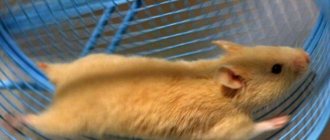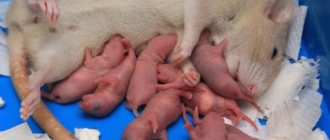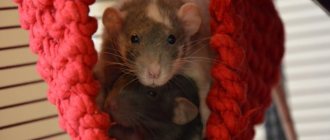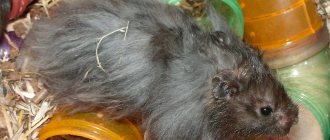- home
- Reproduction
14.07.2018
Djungarian hamsters differ from other breeds in character, habits and disposition. They prefer loneliness and cannot stand being around other rodents. Reproduction of Djungarian hamsters takes place under certain conditions.
Peculiarities of cohabitation of a pair of Djungarian hamsters
Every breeder is concerned about the issue of reproduction of dzhungarikas. In the wild and in captivity, rodents reproduce in the same way - quickly and constantly.
Hamsters of this breed are solitary by nature. At home, even animals of different sexes are kept separately. Having two pets in the same cage is fraught with a fight for territory. They will bite and scratch, causing injury to each other. Hamsters can only be brought together during the mating period.
Having placed one rodent with another, observe the behavior of the pets. The animal feels uncomfortable in the new territory. Uncomfortable housing causes stress, aggression and loss of appetite in rodents. Pay special attention to the size of the cage in which you place the family of jungarians and nutrition. Only well-nourished rodents are capable of producing healthy offspring.
If animals live in the same cage, reproduction cannot be controlled. The female becomes aggressive and can eat the cubs.
What to feed a pregnant hamster
The domestic animal is quite picky about food, and a pregnant female, even more so, needs only the best food. The course of pregnancy largely depends on it: if the female ate well, then the baby is born healthy. The diet should include all possible nutritional components, vitamins and minerals. It is especially important that the expectant mother’s diet is rich in protein and calcium, since they are involved in the formation of the fetus. Therefore, the daily menu must include:
- lean chicken or turkey meat (not raw or fried, but regular boiled meat without salt and spices);
- chicken eggs (whites only);
- fresh vegetables, preferably carrots, beets;
- cereals, sprouted seeds;
- fresh greens and grass.
Each portion should be small, since most of the listed products have a short shelf life.
If necessary, the lack of nutrients can be compensated for with special vitamin supplements that are soluble in water. If you have a calcium deficiency, for example, you can add chalk particles to your drink.
Juicy feed
Syrian hamsters, like other species, are predominantly nocturnal. Therefore, food, as a rule, lies untouched all day and disappears by morning. There is no need to force-feed a pregnant hamster or worry that the female is not consuming enough vitamins and nutrients.
The basis of food for these animals is grains or cereals. Syrian hamsters are usually given one tablespoon morning and evening of barley, oats or wheat germ. But, in addition to this, you can give juicy, fresh food, for example:
- cucumbers;
- Brussels sprouts or cauliflower;
- carrot;
- turnip;
- zucchini;
- eggplant;
- peas and legumes;
- pears (read carefully how);
- apples.
Fruits and vegetables must be cut into small pieces before feeding. Portions of sweet fruits must be strictly controlled, otherwise the animal faces diabetes.
Syrians are prohibited from giving potatoes, red cabbage, exotic and citrus fruits, and nuts, especially Brazil nuts. All sweets are contraindicated for Djungarians - watermelon, melon, etc.
Protein feed
Protein food should be given to a pregnant dwarf (and Syrian hamster too) several times a week, optimally two to three times. This will ensure the normal formation of the cubs’ fetuses, their correct and timely development.
From protein foods you can:
- dietary lean meat: chicken, turkey, sometimes rabbit or beef;
- baby meat puree from the listed types of meat. You can make it yourself using a blender or buy ready-made;
- boiled chicken eggs;
- dairy products: low-fat cottage cheese and low-fat yogurt without sugar and various flavoring additives.
The meat must be boiled, otherwise the hamster is at risk of infection with helminths.
Dry food
The main component of a rodent's diet is dry food or a cereal mixture. It is usually given in limited quantities, but during the pregnancy of a hamster, the usual portion can be increased, since the animal needs more strength and energy to bear the babies. The most common brands of feed are:
- JR Farm.
- Prestige.
- Benelux.
- Padovan.
- Fiory.
- Vitakraft.
The composition of such grain dry food includes various cereal crops. They are rich in vitamins, minerals and nutrients, as well as fiber, which is essential for normal digestion.
Water
The next important component of a pregnant hamster's diet is water. It plays an important role in all processes occurring in the animal’s body and is responsible for its well-being and health. A pregnant hamster needs a lot of clean drinking water per day. Therefore, it needs to be changed daily or more often.
How to breed Djungarian hamsters
Breeding rodents at home requires certain knowledge:
- The animals breed quickly, so get one male and two or three females.
- Buy rodents from different stores. This will exclude the relationship between animals.
- Do not crossbreed a Jungarik with a Campbell's hamster, as the offspring will develop diabetes.
- Pay special attention to the color of rodents. Tangerine-colored couples often have stillbirths. Pearl-colored hamsters do not produce offspring.
- Prepare a breeding room for animals in advance.
- Keep records of mating, pregnancy and birth.
The main rule is to take care of the physical condition and nutrition of rodents. Only healthy hamsters give strong offspring.
At what age do jungarians begin to mate?
Puberty in hairy hamsters occurs at 1-2 months. It is better to pair with a younger male and an older female. Ideally, the boy will be 3 months old, and the girl – 4. It is at this age that the female will be ready to take care of the offspring, and childbirth will become safe for her body.
If you still do not have information on how to determine the sex of hamsters, then you can do this already a month after birth. To do this, measure the distance between the animal's anus and genitals while lying on its back. If it is 0.5-1 cm, and in the center of the abdomen there is a small bulge - the male gland, then this is a male. Already at 2-3 months you will be able to see the testicles. If the distance is less than 0.5 cm, and there are 2 rows of nipples on the stomach, then it is a female. The female is also usually slightly larger than the male.
Important! A month after birth, females and males must be placed in different cages.
How to tell if a female is ready to mate
A hamster does not have particularly noticeable signs that indicate its readiness to reproduce. The onset of estrus can be determined by the girl's reaction to the male. She will treat him friendly and calmly react to his approach.
In females, estrus occurs every four days. Its duration ranges from four hours to one day. During this period, some females raise their tail and arch their back.
If you want to breed Djungarian hamsters, have time to place a male with a female during the period of ovulation.
Determining pregnancy
If 3-5 days after mating the hamster does not go into heat, then the “date” was successful and she is pregnant. This can also be determined by the weight of the animal. Regular weighing on an accurate scale will help determine whether the female is pregnant. Its weight can add up to 10 grams, which is quite significant for such a small pet. Also, the behavior of a pregnant female may change:
- curls up into a ball;
- shows increased aggressiveness;
- walks slowly and carefully;
- looks for quiet, inconspicuous corners, arranges a nest;
- she constantly wants to eat and drink.
Visually, pregnancy appears after 10 days after mating, the female becomes round. Her mammary glands also swell and become larger than usual. On average, the pregnancy of Djungarian hamsters lasts about 3 weeks - from 18 to 21 days.
The cage must be prepared before birth
Preparing the room
Animals of different sexes are kept in different apartments. During mating, the female is placed with the male. The father is resettled immediately after fertilization. A pregnant hamster becomes nervous and the male irritates her. This negatively affects the health of the cubs.
There are several rules for preparing a room for breeding animals.
- For mating, prepare a carrier or a spacious box.
- One cell is left in reserve. Place newborn hamsters in it.
- The cage size for a pair of rodents is 50 by 40 cm.
- To prevent your animals from having health problems, install a running wheel in your home. The optimal wheel diameter is 20 centimeters.
- Animals should always have clean water and fresh food in their house.
- You cannot install a cage with newborn animals in a room where there are drafts.
- The temperature in the room with animals should be about 25 degrees. Ventilate the room.
- Place the rodent cage in a quiet, dark place.
When the young animals are one month old, the animals can be separated from their mother.
Care of offspring
After giving birth, the mother needs rest - at least for a week. After this time, she will again be ready to mate and conceive.
A nursing mother will need good nutrition and a constant supply of clean water . It is advisable to purchase special food at a pet store so that the hamster’s breast milk is as rich as possible in the vitamins and minerals necessary for the normal development of healthy offspring.
The cage where the babies are located must be spacious - at least 50 by 30 cm. The temperature in the room where the babies live must be maintained at 21-25°C . The house with newborns should be in a shaded, quiet place.
Thus, the owner must create all favorable conditions for the new mother, but not interfere in the process of caring for the babies.
If the mother nevertheless abandoned the cubs, then you need to try to feed them yourself. For this you will need baby formula. However, the chances of survival for abandoned babies are low.
Matching
Only a properly selected pair of rodents can produce healthy offspring. When choosing individuals, consider the following:
- Choose a female and a male of the same age. This will avoid conflicts.
- Friendly and calm animals will establish contact faster.
- Rodents must not be related. Buy pets from a professional breeder.
- You cannot mix hamsters of different breeds.
- A female individual should not weigh less than 40 g. A small female will die during childbirth.
Complications during childbirth
Toxicosis
A disease that occurs in the last days of pregnancy. Leads to the death of the female and brood during childbirth or in the first days after. There is no cure.
Pathology of childbirth
In females older than 10 months, the joints of the pelvic bones lose their elasticity, which is why the animal cannot give birth. Large fruiting is possible if there are few cubs (1-3 pieces). In such situations, strong contractions of the uterus cannot push the fetus out. If the female pushes for more than 10-15 minutes, and the baby does not appear, a caesarean section is necessary.
How long it takes hamsters to give birth depends on the number of children. The mother can rest for a long time between the birth of her babies, and even eat. There should be no unproductive fights.
Death of fetuses in the uterus
With infections, poor nutrition or genetic deformities, the cubs may die. The female is unable to give birth and dies from sepsis. Treatment is surgery to remove the uterus.
Dzungariki: reproduction
Pregnancy in an individual lasts about 20 days. During this period, the female needs to create comfortable living conditions. She should not be nervous or irritated. You need to feed the rodent fresh herbs, fortified food, and protein foods.
A hamster gives birth to 2 to 9 babies. The offspring feed on milk for about a month. Three months after birth, the animals can be brought together again. There is no need to do this more often, since pregnancy and childbirth cause harm to the body.
After six births, it is undesirable to cross rodents.
How does pregnancy proceed in a female dzhungarika
A few days before giving birth, you need to put things in order in the cage - thoroughly wash and disinfect. Replace the bedding, add fresh food, and ensure that the hamster always has access to fresh water. Also, the cage must be equipped with a special house so that the female has the opportunity to retire.
It is forbidden to stroke, touch or touch newborn young animals with your hands, because the female hamster, sensing a foreign odor, may eat her offspring. During pregnancy, it is necessary to include protein foods in the female's diet. This can be boiled chicken, low-fat cottage cheese and boiled egg white.
Reproduction of Djungarian hamsters
Reproduction of Djungarian hamsters at home sometimes occurs spontaneously - if a couple is kept in the same cage. It is enough to make a mistake in determining the sex when buying young hamsters. It happens that they buy an already pregnant female. It’s another matter when breeding rodents is a conscious decision. Then the approach to the issue becomes professional, and the reproduction of dzungaria is strictly controlled.
Steps
Part 1
purchasing hamsters for breeding
- Decide what type of hamsters you want to get.
Syrian hamsters make great pets, partly because they are solitary animals, but they can be difficult to breed. If the male and female are introduced at the wrong time, they may start fighting. Djungarian hamsters can be biting with people, but they are more socialized with their relatives and are easier to breed.
- There are also Russian hamsters, as well as many other varieties. If you purchase hamsters from a breeder, talk about the different varieties of hamsters to find out how well socialized they are, or vice versa, to get some insight into the breeding process.
- Buy a male and a female.
It is best to purchase hamsters from a breeder so that you have a wide choice in the color and type of hamster. It’s also a good idea to learn the pedigree history of hamsters.
- Pet stores often sell related hamsters or mixed breeds of different breeds, which are not advisable to breed. Also, often in a pet store it can be difficult to determine the sex of hamsters.
The eyes should be clean, bright, the fur should be smooth and shiny, and the hamsters themselves should be active and show interest in their surroundings.
Buy two large hamster cages.
Plastic containers or aquariums work very well for raising hamsters. Place each hamster in its own cage and fill the bottom with sawdust or other natural bedding. Try not to use fine sawdust, as it gets into your hamsters' eyes and can be harmful to their respiratory system.
- Avoid using metal cages. Hamsters, especially babies, can crawl through bars.
Buy a small plastic “hamster house” for your hamsters to sleep in. Fill it with the same sawdust as the bottom of the cage.
Do not pet them or take them out of the cage, make sure that the hamster has enough everything so that he can do without your intervention. It's best to start handling your new hamster the day after you bring it home.
Breeding hamsters
- Wait until the female is ready to breed.
At the age of 28 days, hamsters become sexually mature. The female is ready to breed approximately every 4 days. In this case, her behavior is very similar to that of a cat: she begins to crouch to the ground and lift her tail. You may also notice that your hamster begins to smell stronger due to the release of pheromones.
- If the female is not ready to breed, attempting to breed hamsters can be dangerous and counterproductive. The female will start fighting and may kill the male.
When you plan to breed hamsters, place two cages close to each other for several days so that the hamsters can see each other, get used to each other, and the ferromones do their job.
Hamsters are nocturnal animals, so it is better to do this in the early evening. Place the hamsters on neutral territory, in a spare cage, as the female may attack the male if he is brought to her on her territory. If the hamsters start fighting, remove one of them and try again another day.
- Continue following these steps until they mate. If you miss the moment when the female is ready, wait a few days until it comes again.
While some male hamsters can care for their young, others can eat them. It is better to protect yourself, even if your hamster is very kind and caring, and keep him for the period of pregnancy and childbirth, which takes about two weeks.
- When breeding Djungarian hamsters, the time until puberty is reached and the duration of pregnancy is slightly longer. Reaching sexual maturity in a Djungarian hamster can take from 4 months to a year, and pregnancy lasts about three weeks.
Birth of hamsters
- Wait.
At this stage, you must be patient and watch the progress. If a female is pregnant, this will become noticeable within a few days, and by the time she is ready to give birth, her sides will stick out very clearly. You don't need to do anything special, just don't grab the female roughly, it's better to leave her alone.
- collecting food and nesting material for their nest. As labor begins, you will notice that your uterus begins to dilate and small pink bodies emerge. They will be born one after another while she rushes around the cage, and one by one she will drag them into the nest.
When a female gives birth, do not try to intervene to help. Childbirth, especially the first birth, is often difficult for the female, but there is nothing you can do to help her at this stage. Just don't interfere and let nature do its thing.
- Looking after the offspring.
Now and for some time afterwards you should not disturb the female in any way. If she leaves the babies lying at the bottom of the cage, you should not touch them. If for any reason you need to do this, take a spoon, rub it well on the bedding in the cage, and then use it to pick up the baby and return it to the nest.
- Allow the mother to care for the babies for three weeks without disturbing her or even cleaning the cage.
Leave her, the cage, and especially the babies alone, except for the careful addition of food and water. This is especially important for a female who has given birth for the first time, who is under the influence of stress, there are times when she can kill and even eat her children.
- Don't think that a mother is going to eat her babies if she puts them in her mouth. This happens when she is scared and believes they are in danger.
You can notice that the female is ready to mate by running your hand over her body. If it sinks to the ground or arches slightly, it may be ready.
- Make sure your hamsters are ready to mate before you try to breed them.
- Don't worry if the mother kills or eats a few babies in the first few weeks. This is normal behavior to weed out weak offspring that would not survive in nature.
- Loud music can make hamsters nervous.
Since you are already here, then most likely you have already read ours, reduced to one article. Therefore, today we will talk about such a breed as, about which we have already written.
Now it's time to talk about reproduction. Did you know that Djungarian hamsters reproduce very easily and quickly in captivity?
Therefore, if you become the owner of a pair of such small rodents, then you should prepare for the fact that your hamsters will soon have abundant offspring, and they will appear with enviable frequency, which is what we’ll talk about today.
How to breed Djungarian hamsters
Prepare the room
Before mating, cages for heterosexual young animals and a small mating carrier are prepared. Adult animals are each kept in their own cage. It is advisable to have at least one at home in reserve if the offspring cannot be accommodated in time. Although Djungarian hamsters are much smaller than Syrians, the cage should be at least 50x30 cm (more is possible). To prevent obesity, hamsters should be provided with a running wheel with a diameter of 16-18 cm. A drinking bowl is required.
In order for newborn babies to feel comfortable, the temperature in the room is maintained at 21-25 C. The female’s cage should be in a quiet place, in the shade. It is equally important to organize adequate feeding. Rodent breeders strive to create ideal conditions for their pets. This serves as a guarantee that the female will not bite her newborn children.
Buying hamsters
To regularly produce offspring, you can keep one male and several females. Animals should not be related to each other. They are purchased from professional breeders or at an exhibition.
When purchasing from a pet store, it is impossible to trace the origin of the rodents; then the male and female are purchased in different stores.
Preference is given to animals with a friendly character and ideal external characteristics. The female should not be too small: an individual less than 40 years old risks not giving birth. The same danger threatens an obese hamster.
Not only inbreeding, but also interspecific crossing is avoided. Djungarian hamsters cannot be crossed with Campbell's hamsters. Although these dwarf species are very similar to each other and produce viable offspring, there is a risk of large births and complications during childbirth (death of the female). Hybrids cannot be judged by exterior at exhibitions, since they do not belong to any one species. Campbells are predisposed to diabetes and pass the disease on to their offspring.
You will have to distinguish dwarf hamsters on your own: sellers often call both Sungur and Campbell hamsters “Djungarian.” It is especially easy to confuse them in the standard color. A distinctive feature of the Djungarians is the widening of the black stripe running along the spine, a kind of diamond on the head.
Matching
Djungarians have a limited number of colors; the most common is natural. Eyes can only be black, unlike Camps. Breeders managed to obtain unusual coat colors:
- tangerine (reddish, sand);
- pearl (white with gray);
- sapphire (gray-blue).
Cubs of a rare color are very valuable, but when breeding Djungarian hamsters with “colored” fur, you need to know the peculiarities of genetics.
You cannot breed two tangerine-colored animals, as they will pass on the lethal gene to their descendants. When mating two “pearls”, some of the fruits will also be non-viable, so the offspring will be few or completely absent.
Otherwise, the colors combine well with each other, giving interesting variations.
Djungarian hamster: reproduction
When kept in groups, hamsters begin to reproduce at the age of 4-5 weeks, but mating of such young animals is extremely undesirable. The female is bred for the first time at 4-5 months. Pregnancy lasts 18-22 days, after which the female feeds the cubs with milk for 3-4 weeks. Both gestation and lactation greatly deplete the body. To preserve the health of the mother and obtain a strong offspring, the female is not fertilized for 2-3 months after birth. A hamster will bring 3-6 litters, after which it becomes dangerous to breed her: after a year, the pelvic bones become rigid and the female will not be able to give birth.
When is mating acceptable?
If you want to get offspring from your pets, you should know how hamsters mate and what you need to pay special attention to. The maturation features of the rodent's body allow it to begin reproduction at the age of 4-6 weeks. In Djungarian individuals, puberty often occurs before 3 weeks. However, you should not bring a male and a female together at such an early age. For females, this is fraught with the following complications:
- Rickets.
- Disturbances in the functioning of the genitourinary system.
- Cannibalism.
Rickets and complications in the functioning of the genitourinary system are caused by the fact that at an early age the entire organism as a whole is actively developing. If the body has not had time to form, and pregnancy has occurred, all efforts are spent on providing the cubs with everything they need, while the female herself is left without nutrients.
Cannibalism is one of the most common problems, which is often caused not only by early birth. It also often occurs due to stressful situations, when the female feels threatened, or if the animal is unwell and unable to feed its young.
The most suitable age for mating is 4-6 months. It is advisable to meet this deadline, since late breeding (after 6 months) for the pet can result in complications.
Breeding hamsters at home must be carefully controlled. In no case should mating be allowed to occur earlier than 4 months after the previous pregnancy. This is necessary so that the female:
- fully recovered after childbirth;
- fed the offspring;
- gained strength and restored all the substances necessary for the body before a new pregnancy.
At the age of one year, a hamster may completely lose the ability to bear and feed babies. In the case of males, everything is much simpler - they can mate starting from the 5th week of their life, and their ability to produce offspring remains throughout their lives.
How do Djungarian hamsters reproduce?
Males and females are kept in individual cages, and mating is carried out on neutral territory - in a box or carrier. Animals can fight, so you need to keep an eye on the process. The female estrus occurs every 4 days and lasts about a day.
The difficulty is that the signs of estrus in dwarf individuals are difficult to see. It can only be determined by the female’s reaction to her partner.
Dwarf hamsters - Djungaria and Campbell - are not as aggressive towards each other as Syrian ones. Therefore, you can often hear about cohabitation. This is convenient for the owner: there is no need to organize mating; it is necessary to clean and maintain one cage, not two. But the disadvantages of this approach outweigh the advantages.
If there are different-sex dwarfs in the same cage, reproduction cannot be controlled. The female gets pregnant too often. Bearing fruit coincides with lactation, the animals die, fight, and devour offspring.
How to tell if your hamster is pregnant
It is not so easy to immediately determine and understand that a hamster is in an interesting position, since the belly of expectant mothers increases only in the second half of pregnancy. What does a pregnant hamster look like?
Important! Signs of pregnancy in hamsters are very indirect, and you can understand whether a hamster is pregnant if you do not know exactly when mating occurred only by the changed behavior of the small animal.
At the same time, you need to understand that, like people, hamsters have their own character, disposition and temperament, therefore, at the beginning of pregnancy, females behave differently. Some become calmer and more peaceful, while others, on the contrary, show anxiety and even aggression towards their relatives or owners. A pregnant dwarf may have increased appetite or thirst.
Important! Visible signs of pregnancy in hamsters appear approximately 10 days before birth.
Pregnant female dzhungarika
Approximately in the middle of pregnancy, the female begins to equip a maternity “nest”, dragging improvised material into it. At the same time, the most reliable sign that allows you to understand that a hamster is pregnant is an enlarged, rounded tummy. By the middle of the term, the nipples enlarge and swell. A pregnant jungarik in the last week before giving birth resembles a large pear. A hamster that is carrying babies tries to move carefully, slowly, and spends little time in the play wheel.
Before giving birth, female hamsters set up a maternity “nest” or rebuild their house.
If you are wondering whether your hamster became pregnant after mating, you can do a simple test.
about eight days after mating, examine the female with your hands. Carefully place the animal with its front paws on a flat, hard surface, and clasp its tummy with your hands from behind. The thumbs will be on the back, and the rest will be on the stomach. Feel the tummy from the ribs to the pelvic bones. This way you can feel the fruits, which resemble small balls to the touch, and you will understand that the hamster is pregnant.
A few days before the babies are born, hamsters become very restless, they can rush around the cage, carry various objects and food supplies into the maternity nest. In this case, the hamster can simultaneously prepare several birthing places in the most secluded corners of the cage.
Reproduction of Djungarian hamsters: arguments against
Less life expectancy
The hamster already lives for a short time, and if the body is exhausted by producing offspring, it lives almost twice as long. If the pet does not die due to birth pathology, the breeder maintains until death a female older than a year, which can no longer make a profit.
Less communication
In order not to provoke cannibalism (eating her own young), the female needs to be provided with privacy. During pregnancy, when the animal is preparing the nest, and then during lactation, it is undesirable to pick up the female or disturb him in any other way. This must be taken into account if the rodent belongs to children.
Requires time and financial investment
Dwarf hamsters will grow up wild if the young are not tamed. It is necessary to handle hamsters daily, showing patience and caution. This takes a lot of time, and you also need to organize feeding, change the water, and clean the cages.
Before placing young animals, the sex of each animal must be determined. Hamsters need to find owners. New owners are interested in many questions about maintenance and nutrition; the breeder will have to answer them, unless he sells the cubs in bulk to the poultry market.
How does childbirth occur?
Usually hamsters cope with childbirth themselves. Most often this happens at night. The offspring is born in a special shell, which the mother then gnaws through in the area of the baby's head, and the babies have the opportunity to breathe independently. An inexperienced female can eat her pets, there may be several reasons for this:
- improper diet during pregnancy, especially lack of protein in the diet;
- early maternal age;
- stress or fear after childbirth;
- there is a male in the cage after childbirth, he poses a threat to her children, so she directs aggression either at him, and if this fails, then at the cubs;
- regulation of the number of offspring; if too many of them are born, the mother will not be able to feed them on her own;
- if the cub was born weak, sick or defective;
- if a person picked up a small hamster in his arms in the first seven days after birth, which is why the baby has a foreign smell.
Hamsters are born hairless, blind and deaf.
How long do Djungarian hamsters live?
Most animals die from disease, hunger, or become prey to predators before they even live a year. Very rarely, dzhungarikas manage to live up to 2 years.
Unlike their wild counterparts, domestic Djungarian hamsters live in comfortable, safe conditions. They are not bothered by predatory animals, food is plentiful, and the ambient temperature is stable. Therefore, their lifespan is on average 3 years.
Their ability to reproduce occurs very early and lasts up to one and a half years in females and up to 3 years in males.
Hamsters are very cute and fluffy animals that are highly fertile.
Breeding Djungarian hamsters at home
In nature, the breeding season of hamsters falls during the warm season (May - September). Domestic dwarfs mate all year round. Therefore, in order to avoid the unplanned appearance of offspring, it is recommended to keep hamsters of different sexes in separate cages.
The beginning of mating of hamsters
The animals can bear their first litter at the age of three to six weeks.
At this time, hamsters are just entering the active growth phase. The internal organs and skeleton are not yet formed, and pregnancy can cause serious harm to health.
Mating at this time is fraught with:
- The appearance of non-viable offspring.
- Shortening life.
- Complicated pregnancy.
Therefore, it is recommended to use for breeding females that have reached 4 months. At this age they reach puberty, and all organ systems are already formed. Later age may also be an obstacle to the appearance of offspring.
If the female has never been pregnant before 6 months, then it is better not to use her for breeding - the risk of complications is too high.
There are no such restrictions for males - they can fertilize a female from 5 weeks of age and remain good producers until the end of their lives.
How to tell if a female is ready to mate
Sexual intercourse in hamsters occurs only after the female enters the estrous cycle (estrus), which occurs with a frequency of once every three to five days and lasts from four hours to a day.
The first sign of a female’s readiness is her changed attitude towards the male: when he approaches, she lifts her tail, spreads her paws, and arches her back.
In addition, signs of the onset of estrus:
- anxiety;
- loss or decreased appetite;
- the appearance of a sharp musky odor.
For most Djungarians, the onset of estrus is indicated only by a changed attitude towards the opposite sex.
You should know that in winter some females do not go into heat.
Matching
To get healthy, viable offspring, you need to competently approach the choice of future sires:
- Both animals must be active and healthy.
- The weight of the female should not be less than 35-40 grams. Weight loss during gestation and feeding of cubs is up to 40% of the total weight.
- Color and conformation should correspond as closely as possible to the standard.
- Animals should not show signs of obesity. Overly plump hamsters often turn out to be infertile.
- Hamsters should not be closely related. Inbreeding increases the chance of developing pathologies and deformities in the offspring.
Often a hamster attacks a male who does not please her, even during estrus. Therefore, for breeding, two to three females are usually prepared for one male.
Hamsters should be introduced on neutral territory or in the male’s home
How do hamsters mate?
In order for hamsters to mate, they need to prepare a separate cage. It is impossible to bring animals together in the territory where one of them lives permanently - Djungarians have a highly developed territorial instinct and such an attempt can end in a fight.
The cage is placed in a quiet place where nothing will distract the hamsters from the process.
In the evening, first the female is released there, and after 10 minutes the male. If the animals like each other, they will soon begin sexual intercourse. If not, they are seated in separate cages, and the attempt is repeated later.
The mating process takes no more than half an hour. During this time, several sexual acts occur with short breaks.
What to do after mating
Immediately after mating, the animals are placed in separate cages, even if they do not show aggression towards each other.
Under the influence of pregnancy, the female's character and behavioral reactions undergo changes, and she will constantly provoke conflicts.
Which will negatively affect the condition of future offspring.
Pregnancy and childbirth
Pregnancy among Djungarians lasts from 16 to 20 days. The first signs appear on the 10th day after mating. From 5 to 18 cubs are born at a time.
Small pets need attention, feeding and cleaning after them
Childbirth takes place in a special nest, which the female begins to equip a couple of days before giving birth. In order for her to build a suitable place, more filler is placed in the cage, which can be used for construction.
Puberty
1 month after birth, Djungarians reach puberty and are ready to mate. Veterinarians advise not to rush and let your pets grow a little more. Upon reaching the age of 3 months, you can start breeding dzhungarikas.
If you start breeding before the recommended age, the female will simply eat her offspring due to the lack of maternal instinct. The ideal age for first mating is 3-8 months. The older the female becomes, the less opportunity she has to reproduce. Therefore, you should not delay this (hamsters at the age of one year become pregnant extremely rarely).
Djungarian hamsters. Reproduction
You can’t order your heart... The female herself chooses a suitable male
Djungarian hamsters breed very easily in captivity. And if you become the owner of a pair of dzhungarikas, get ready for the fact that they will regularly have babies.
Keeping male and female Djungarian hamsters together
Experienced hamster breeders advise keeping the female and male in separate cages and uniting the “family” only for the mating period.
This is done in order to avoid conflicts and struggles for territory, which can result in bites and scratches. But it is not uncommon for a hamster family to live together throughout its life.
It is quite difficult to predict how events will unfold in the cage, so it is better to rely on your intuition, and then act according to the circumstances.
Once you have placed a male and a female together, monitor their behavior. Sometimes, perhaps, they will begin to sort out their relationship very violently, but the male is always ready to concede victory in an argument to the female, without showing aggressive actions towards her.
It is advisable to keep a pair of dwarfs from an early age, so they can live together normally. Adults that have lived separately require additional precautions.
First, it’s worth placing them next to each other in a cage with a partition so that the hamsters get used to each other’s smell. After some time, the partition can be removed and the cage can be placed in place with bright light.
This will provoke them to hide together in the darkness, and they will cling to each other, which will speed up the process of habituation. One male Djungarian hamster can live with several females.
When can you mate Djungarian hamsters?
Sexual maturity of female hamsters occurs at the age of one or two months, but it is better to wait until mating until 3-4 months, when the female is already able to take care of her offspring.
Dungar hamsters are animals that lead a predominantly nocturnal lifestyle in the natural environment and in home conditions of keeping hamsters. Therefore, mating and childbirth also occur in the dark. Every 4-5 days, a female Djungarian hamster goes into estrus, the duration of which can be from 4 to 24 hours. The female is ready to accept the male only at this time.
Signs of estrus in a female Djungarian hamster: in the presence of a hamster and even without him, she raises her tail and arches her back. At this time, you can place the female with the hamster. If you see aggression on the part of a female, it means she is not in estrus or simply does not like the male. Monitor her behavior and try again in a day. Repeat the hamsters’ “dates” until they are successful.
Pregnancy in a female Djungarian hamster
Pregnancy in a female Djungarian hamster lasts from 17 to 21 days, if it takes longer, urgently go to the veterinarian for help. During pregnancy, the female should not be worried.
Add more fresh vegetables and fruits to her diet and take care of protein nutrition, which is so important during this period.
Protein-rich foods: egg whites, boiled chicken, gammarus, meat baby food and dairy products. Be sure to give her a mineral chalk stone.
The expectant mother will intensively prepare the nest for her cubs, and for this she needs building materials: put paper napkins in her cage. Remove the house from the cage in advance, and hide the running wheel two to three days before the birth.
Offspring of Djungarian hamsters
A female can give birth to from two to nine cubs, in rare cases there can be 18 of them, then there are cases that the mother hamster eats weak or sick hamsters. Little dungarian cubs are born blind and naked, completely without hair. Their eyes will open at the age of two weeks. So it’s not worth picking up the babies and cleaning the cage until this time.
Breeders advise separating hamsters by gender at one month of age, since, starting at this age, they are already capable of mating.
It is important to keep dad separate from the family: his paternal feelings may let him down and he will eat the entire litter.
Install a drinking bowl in the cage with the nursing female so that she gets as much water as she needs. Provide her with the right food and clean water.
Add special food to her so that the milk contains enough vitamins and minerals for the development of babies.
Try to interfere as little as possible with the process of birthing and nursing hamsters, so as not to scare away the mother’s desire to raise and feed little dwarfs.
When you decide to become breeders of Djungarian hamsters, try to approach this process as naturally as possible, but do not allow hamsters to reproduce chaotically at a young age.
Place mature hamsters in a timely manner and monitor all stages of the breeding period of dwarf hamsters. Create comfortable conditions for keeping, breeding, pregnancy and birth of Djungarian hamsters.
This is quite an interesting and entertaining activity that will bring you a lot of positive emotions.
Breeding Djungarian hamsters
When can you give away hamsters after birth?
Hamsters develop very quickly, so already at the age of one month they can be given into the wrong hands. Until the 21st day, they should be close to their mother. Then, no later than the 28th day, they should be removed. They must live in a separate cage for some time before being sold. The new owner should be given some bedding from the old cage and food so that the babies quickly adapt to an unusual place - a familiar smell and familiar food will reduce stress.
Breeding hamsters at home: preparation and care - Breeding
Hamsters are quite calm and unpretentious animals that simply cannot help but evoke affection. Before you have such a pet in your home, you should familiarize yourself with the intricacies of keeping and caring for them. Hamsters don’t take up much space, and they don’t cause much trouble.
You can keep them in a metal cage (rodents will sooner or later damage wooden rods and escape) or in a terrarium. But put jars, buckets or boxes aside.
You should not allow hamsters to roam freely around the apartment: firstly, miniature animals easily get lost, and secondly, they gnaw on everything they can get their teeth into.
Arrangement of the cage
The monastery should be quite spacious; sawdust, odorless corn and wood filler, coarse sand should be placed at the bottom, but cotton wool and shreds should not be placed in the cage.
A shelter is required (it can be a wooden house or an upside-down clay pot with a hole). You can train rodents to go to the litter tray - there are even special toilets with litter on sale.
The sooner you start training, the greater the likelihood of success; it is almost impossible to retrain an adult.
To prevent the animal from getting bored, it would be good to purchase climbing tubes, build “minks”, ladders, a wheel is also useful for hamsters, but it should not be mesh or slippery.
It is better to choose an adjustable, drip-type drinking bowl, since hamsters like to turn the drinking bowl over or splash water out of it.
The feeder must be securely attached to the grate or be heavy so that the animal cannot turn it over.
Can you imagine a hamster without a pantry? – In some part of the cage, your pet will definitely equip itself with storage, where it will hide part of the food “in reserve.” When cleaning the cage, be extremely careful and do not take away the hidden food, otherwise the animal will be really stressed.
Hamster nutrition
The main part of the diet is various grains and cereals, often ready-made mixtures include: wheat, oats, sunflower seeds, peas, and some types of nuts.
Pets love pieces of vegetables and fruits: apples, pears, bananas, lettuce, carrots, tomatoes, pumpkins, cucumbers, squash, zucchini.
You should not give rodents bread, cabbage, potatoes, citrus fruits, persimmons, spicy or too sweet foods.
Pregnancy and birth of hamsters
A hamster's pregnancy lasts on average only 14-19 days, while in Djungarian hamsters the pregnancy can last up to 30 days. On the tenth day, visible signs of pregnancy appear, and it is from this moment that the expectant mother’s weight begins to rapidly increase. If the female's weight decreases during pregnancy, this may indicate illness or death of the embryos inside the womb.
Approximate duration of pregnancy for:
- Syrian hamsters and Roborovsky hamsters – 16-17 days;
- Campbell's hamsters and Siberian hamsters - 19-20 days.
Expectant mothers move very carefully, trying not to make sudden movements. Do not disturb a pregnant female unless absolutely necessary! Include more protein in her diet (this could be egg whites, cheese, cottage cheese, baby meat food, etc.).
3 days before giving birth, the female’s thirst increases. During this time, the water should be changed at least 3-4 times a day.
Labor usually begins at night. Set up a house or nest in the cage in advance (you can use a cardboard box). The hamster arranges everything inside the nest herself, just don’t forget to provide her with soft paper, napkins and hay. The cage where the hamster will give birth should be in a quiet and peaceful place.
Usually the pet copes well with the birthing process on its own, and in the morning the owners discover a new baby. Hamsters are born in a shell, the mother gnaws it in the area of the baby's head, and the baby takes its first breath. Each hamster litter can have anywhere from four to eighteen babies. Babies are born completely helpless, deaf, blind, tiny, their skin is thin and red. The only thing that babies have perfectly developed is the ability to distinguish smells.
Experienced breeders and veterinarians can help with the birthing process when a female is giving birth for the first time or when a large number of babies are being born.
But there are times when during the birth process the help of a veterinarian is necessary, namely:
- if, with obvious contractions and pushing after 15 minutes, there are no results
- After the birth of the first baby, after 30 minutes, the remaining babies are not born.
Within 30 min. After giving birth, a healthy mother will definitely eat before starting to feed her babies. Refusal to eat may mean the occurrence of any postpartum complications. The vaginal membrane closes in the first two days after birth, and at this time you may notice slight bleeding from the birth canal.
The first time a hamster usually gives birth to 4-5 babies, subsequent litters can include many more babies.
We are mating
In order for mating to be successful, you must first introduce the hamsters. Hamsters should be introduced on neutral territory or in the male’s home.
Under no circumstances should hamsters be kept in a female's cage.
A good place for mating would be a cardboard box, because if the hamsters start fighting in the cage, you will not be able to quickly separate them, and the animals will be able to harm each other during this time. And you can quickly take the fighters out of the box and return them to their cages. But you shouldn’t separate struggling hamsters with your bare hands. You can wear leather gloves to protect yourself from hamster bites.
It is not only the lack of sexual heat in the female that causes fights between two individuals of different sexes. In their natural environment, hamsters are loners, so conflicts often arise between them. There are cases when a young and inexperienced male gets a lot of trouble from a female, who uses her teeth and claws, causing serious wounds.
Hamsters often stop fighting very quickly and mate successfully. This process most often occurs at night and lasts about 5 minutes. Typically, these rodents mate several times with short breaks. Sometimes males are so active that after mating they lie exhausted, as if dead.
Hamsters are seated after mating, as soon as they lose interest in each other. Otherwise, if the female is pregnant, the fights will continue.
There are cases when the female does not become pregnant the first time, so the mating process must be repeated until a positive result is obtained.
If you constantly keep a pair of opposite-sex hamsters in the same cage, they will mate as soon as the female goes into heat. With such free mating, the female can simultaneously experience lactation and pregnancy, which greatly weakens the body of this rodent.
Breeding rules
It is important for the future hamster breeder to know that the story about their fertility is a kind of myth. These animals are evolutionarily solitary. If you want to breed them, you will have to take into account many nuances. For example, they cannot be planted in the same cage initially.
Hamsters are conflict animals; they will fight until death.
Therefore, two rodents of different sexes are not enough for reproduction. You will need two cages with dwellings. This rule does not apply to Roborovsky hamsters. This species lives in large groups. When breeding them, you get the other extreme: a flock will require a large cage with enough space for each individual. Otherwise, fights will begin for free space. According to the recommendations of experienced breeders, this type of hamster is ideal for trial breeding.
Related Posts
Breeding the popular Djungarian hamsters will require a lot of effort and investment (like almost all rodents). You will need several cages: separate ones for adult males and females, another one for the grown litter (1–2 months), and then several more for housing the young animals without exception.
The breeder needs to remember that hamsters, regardless of breed, will breed 3-4 times a year. This is not the limit, but a larger number of litters will have a bad effect on the condition of the female. Therefore, immediately after giving birth, it is better to move the male into his cage. You also need to be prepared for the fact that the hamster may destroy some of the offspring if it realizes that it cannot feed everyone (this is natural for rodents).











